Celebrating conservation success with art
By Ilana DeBare
We’re sadly accustomed to stories of environmental tragedy – dying coral reefs, melting ice caps, rivers with no salmon. Shouldn’t we also highlight stories of conservation success, where species are brought back from the brink of extinction?
That was Robbie Brandwynne’s idea when she decided to organize Celebration, an art exhibit on display through Aug. 31 at the Environmental Education Center in Tilden Park.
The exhibit features works by 60 artists depicting birds, animals and plants that faced extinction but have at least partially recovered.
Peregrine and Prairie Falcons. California Clapper Rails. Golden Eagles, Bald Eagles, Belding’s Savannah Sparrows and more…
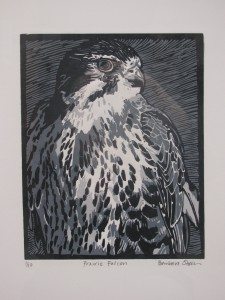
Some but not all of the works are accompanied by short explanations of the species’ threat and revival. A note alongside Barbara Stikker’s striking linoleum reduction print of a Prairie Falcon notes that in 1977, when it was listed as a federal species of concern, there were only 300 to 500 pairs left in California.
Today the population has stabilized at more than 5,000 pairs, thanks in part to the use of fallow and flooded rice fields as bird habitat in the Central Valley.
Several of the species in the show owe their survival to a single environmental initiative — the banning of DDT in 1972. The ubiquitous pesticide made Bald Eagle eggs so brittle that they couldn’t withstand the weight of a brooding adult. Listed as endangered in 1967, Bald Eagles were removed from that list in 1995 and then removed from the list of threatened species as well in 2007. Similarly, Brown Pelicans had been listed as threatened in 1970 but, once DDT was banned, they recovered enough to be delisted in 1988.
It was a newspaper photo about the delisting of the Brown Pelican that initially inspired Brandwynne, a retired psychotherapist and medical researcher who currently quilts and paints watercolors.
“That photo meant something to me, and an idea began to grow,” said Brandwynne, an Oakland resident. “People don’t hear enough of the good news in general, and we hear way too little of the good news about conservation. That message — the pelican portrait — means that conservation and restoration really do work when adequately funded and implemented.”
One of the most interesting features of the exhibit is the way multiple artists depict the same species. Some are as detailed and naturalistic as images from a field guide; others are more abstract and stylized. It’s like the fable of the five blind men and the elephant: Everyone perceives the same animal a different way. Take these three views of Brown Pelicans:
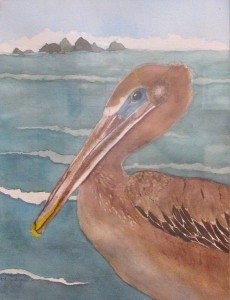
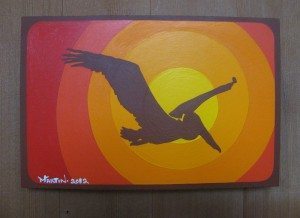
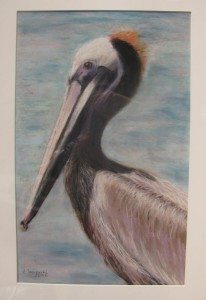
The exhibit — co-sponsored by the East Bay Regional Park District and Merritt College’s Environmental Management and Technology Department — is open Tuesday through Sunday, 10 to 4:30 p.m.
On June 10th at 2:30 p.m., the Nature Center will host a free talk by wildlife photographer Rosalie Winard, author of the book Wild Birds of the American Wetlands, some of whose work is in the show. (Including yet another take on a Brown Pelican!)

The exhibit includes not just paintings, prints and photos but sculpture and mixed media. Some of my favorite pieces were a mixed media work on California Gulls that seemed to include some quilting, and a sculpture of Palau Owls made out of… beeswax.
The owls, native to Palau in the South Pacific, nearly died off in the 1960s from eating non-native rhinoceros beetles that had been introduced to their island habitat. When the beetles were removed, the owls recovered and in 1985 were taken off the endangered species list.
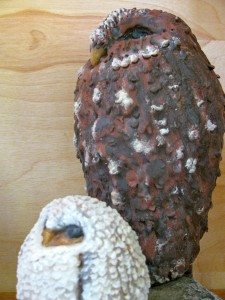
Why beeswax?
The exhibit didn’t say, but sculptor Gina Truex is apparently a beekeeper.
——————–
The Environmental Education Center is located at the north end of Central Park Drive in Tilden Park (Berkeley), next to the Little Farm and Jewel Lake. For more information on the show, click here.
